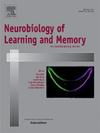bst - GABA神经元在后向条件抑制中的作用
IF 1.8
4区 心理学
Q3 BEHAVIORAL SCIENCES
引用次数: 0
摘要
条件抑制是衡量习得性回避的有效范例。在大多数条件抑制研究中,正向条件反射用于提示预测厌恶刺激的地方。然而,反向条件反射,其中厌恶刺激预测提示,由于其对条件激发和抑制的影响,为学习回避提供了独特的见解。我们训练小鼠在情境A中消耗蔗糖,将情境B中的厌恶刺激与少量或许多向前或向后配对的线索(CS +)联系起来,然后测试情境A中对CS +的条件抑制反应。我们发现少量或大量的前向CS +和少量的后向CS +产生条件抑制,而大量的后向CS +不产生条件抑制。地西泮是GABAA受体的一种正变构调节剂,可以阻止对后向CS +的条件抑制,但对正向CS +没有作用。此外,对正向CS+有冻结反应,而对反向CS+无冻结反应,地西泮对冻结和运动无影响。接下来,我们检查了BNST GABA神经元对向后提示和条件抑制的潜在敏感性。在反向CS +过程中,VGaT BNST信号对蔗糖舔舐的反应增加,但对CS +之外的舔舐和反向CS +的开始或偏移没有反应。利用设计受体,我们发现BNST VGaT神经元的激活,而不是抑制,阻止了反向条件抑制的表达。我们得出结论,后向条件抑制依赖于地西泮和BNST GABA神经元对GABA受体的正变构调节。本文章由计算机程序翻译,如有差异,请以英文原文为准。
Assessing the role of BNST GABA neurons in backward conditioned suppression
Conditioned suppression is a useful paradigm for measuring learned avoidance. In most conditioned suppression studies, forward conditioning is used where a cue predicts an aversive stimulus. However, backward conditioning, in which an aversive stimulus predicts a cue, provides unique insights into learned avoidance due to its influence on both conditioned excitation and inhibition. We trained mice to consume sucrose in context A, associated an aversive stimulus in context B to few or many forward or backwards paired cues (CS + ), and then tested for conditioned suppression in context A in response to the CS + . We found that few or many forward CS + and few backward CS + produced conditioned suppression, but many backwards cues did not. Administration of diazepam, a positive allosteric modulator of the GABAA receptor, prevented conditioned suppression to the backward CS + but not to the forward CS + . Furthermore, freezing behavior was observed in response to the forward CS + but not the backward CS+, and diazepam had no effect on freezing or locomotion. We next examined BNST GABA neurons for potential sensitivity to backwards cues and conditioned suppression. VGaT BNST signaling increased in response to sucrose licks during the backward CS + but not to licks outside the CS + and not to the backward CS + onset or offset. Using designer receptors, we found that BNST VGaT neuron activation, but not its inhibition, prevented backward conditioned suppression expression. We conclude that backward conditioned suppression is dependent on both positive allosteric modulation of GABA on GABAA receptors by diazepam and BNST GABA neurons.
求助全文
通过发布文献求助,成功后即可免费获取论文全文。
去求助
来源期刊
CiteScore
5.10
自引率
7.40%
发文量
77
审稿时长
12.6 weeks
期刊介绍:
Neurobiology of Learning and Memory publishes articles examining the neurobiological mechanisms underlying learning and memory at all levels of analysis ranging from molecular biology to synaptic and neural plasticity and behavior. We are especially interested in manuscripts that examine the neural circuits and molecular mechanisms underlying learning, memory and plasticity in both experimental animals and human subjects.

 求助内容:
求助内容: 应助结果提醒方式:
应助结果提醒方式:


